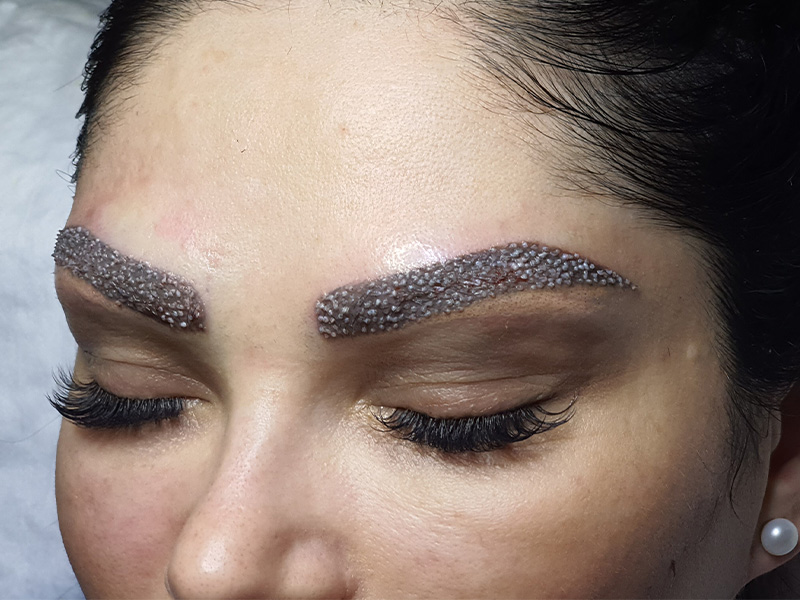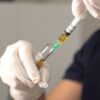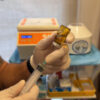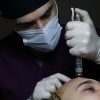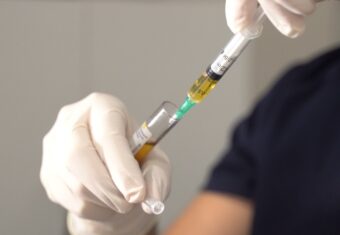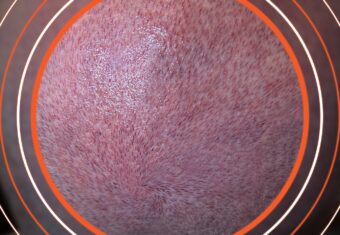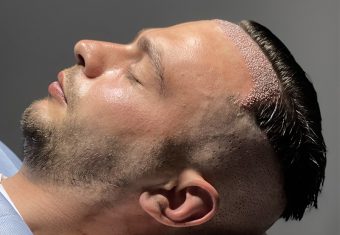Contents
What is An Eyebrow Transplantation?
An eyebrow transplantation is the process of collecting eyebrow-shaped roots from the nape area, called the donor area, by FUE technique, in cases of shedding / thinning of the eyebrows due to genetic or an external factor (such as an accident, used cosmetics, burns, excessive stress, trichotillomania). It is the process of transferring it to the eyebrow area.
Eyebrows fill an important place in our appearance, especially in women. Since it is in profile, it cannot be completely camouflaged in any way. Although it can be supported with aesthetic applications, it is not possible to completely camouflage if there are gaps or sparseness.
In such cases, eyebrow transplant operation offers definitive solutions.
Eyebrow transplantation is not applied only because of existing gaps or thinning. It is a method often preferred by people who are born with thin eyebrows for a thicker eyebrow form.
Eyebrows are one of the main elements that determine the characteristic features of our face, since they are in our profile. The daily life of the person with eyebrow problem is indirectly affected in a negative way.
How Is An Eyebrow Transplantation Performed?
Although it is similar to hair transplantation and beard transplantation in terms of application, there are many points to be considered because the eyebrows are in a different form than hair and beard.
To explain briefly;
Unlike hair transplantation and beard transplantation operations, the thinnest hair follicles in the donor area should be collected in eyebrow transplantation. Since the eyebrows are thin-wire in terms of structure, an eyebrow transplant operation to be performed with strong grafts to be collected from the donor area will unfortunately result in disappointment. For this reason, the donor area should be analyzed well and the hair follicles to be collected should be determined during the planning stage before the operation. After making sure that there are enough fine hair follicles in the donor area, the operation can be started. If the person’s hair is thick, another way can be followed instead of eyebrow transplantation. In such cases, eyebrow transplantation may not be an effective option.
Again, unlike hair transplantation operations, the collection part of the roots in the eyebrow transplantation operation is performed after the preparation of the canal sites, although it varies according to the technique used. There is no need for high graft numbers in eyebrow transplant operations. For this reason, the problem of donor area insufficiency is generally not encountered. A sample is taken from the hair follicles determined in the planning section from the window to be opened with a width of 1 finger in the donor area, and the places where the roots will be placed are prepared based on the samples taken. Eyebrow directions are also determined at this stage. If there are only sparse or partial gaps in the eyebrows, or if the form of the eyebrow is desired to be changed, a planning is made based on the existing eyebrow directions.
The number of grafts to be used varies according to the condition of the eyebrow. After enough space is prepared, grafts are collected from the donor area to be placed in the prepared areas. Another issue to be considered during the collection stage with the FUE technique is that the apparatus used for the collection process must be suitable for eyebrow transplantation. It is not enough to determine and collect only fine hair. The apparatus called ‘Punch’ and used in the collection process should be suitable for eyebrow transplantation.
After the grafts are collected, the placement process begins. While placing the removed hair follicles, it is absolutely necessary to move slowly. Since the roots taken are thin-wired, they can be easily damaged. For this reason, extreme caution should be exercised.
Another important issue is eyebrow density. If the person does not have a chronic disease or a treatment that has an ongoing and side effect on the eyebrows, the condition of the existing eyebrows should also be calculated while determining the eyebrow frequency. Eyebrows do not fall out for genetic reasons like hair. For this reason, a random planning without calculating the condition of the existing eyebrows will cause the eyebrow density to deteriorate. This creates a bad image.
Why Is An Eyebrow Transplantation Performed?
The person may have a congenital eyebrow problem or may experience eyebrow loss due to an external factor. Eyebrow loss after an accident, incorrect use of cosmetics, a side effect of an ongoing treatment, or incorrect eyebrow removal (trichotillomania) can be given as examples of external factors.. Due to the fact that the eyebrows are in profile, it constantly disturbs the person when looking in the mirror during the day, in bilateral relations. Although it can be camouflaged with various aesthetic applications, it is not possible to completely camouflage with an application other than eyebrow transplantation.
The work, family and social life of the person who is constantly disturbed is also indirectly affected by this situation. For this reason, eyebrow transplant operation should not be considered only as an aesthetic operation. After a successful operation, the quality of life of the person will increase indirectly.
To Whom Can An Eyebrow Transplantation Be Applied To?
People with congenital, genetically thin eyebrows can have eyebrow transplantation , while people with damaged/shed eyebrows due to an external factor can have eyebrow transplantation to repair the problematic area.
There is no age restriction as long as people are not very young or very old. Eyebrow transplant operation is not recommended for very young or very old people.
Health status should be evaluated before the operation. It should be investigated whether there is an obstacle to the operation. Especially in women, hormone and vitamin tests should be checked. A successful result cannot be expected from an operation that will be planned without the necessary tests.
When is An Eyebrow Transplantation Necessary?
Operation time changes according to the situation. To explain briefly;
If the problem is due to genetic reasons, the operation can be planned after the characteristic features and face form are established. There may be changes in the profile of the person because the face character of the person will not be settled in the plans to be made at a very early age. It can be used for many years, and in the near future, an uncomfortable image may occur. One of the options that the person may prefer is to plan an operation at an early age, to make a revision if the characteristic features of the face change, and the other is to wait for the eyebrow transplant operation. Since the operation to be performed is an aesthetic operation, the decision maker is the person himself.
What are the Benefits of An Eyebrow Transplantation?
While the main task of the eyebrows is to protect the eye against external influences, they are also complementary to facial aesthetics. It plays an important role in the formation of mimics. Any image disorder that will occur in the eyebrows will negatively affect the social life of people and cause loss of self-confidence. Loss of self-confidence constantly demoralizes people.
With a small touch, all these problems will be eliminated and a more aesthetic appearance will be achieved.
Things to Know After Having An Eyebrow Transplantation
Although the general opinion is that it will be difficult after the operation, contrary to what is known, it is quite comfortable. People can return to their daily lives within 2-3 days. You should lie on your back for 10 days. A neck pillow can be used for the first 10 days to protect the planting area during sleep.
Another important issue to be aware of after the operation is that the transferred roots may continue to grow. The roots, which are hair follicles in terms of structure, return to the form of eyebrow roots over time and the growth rate slows down. In the future, the elongation stops completely.
Things to consider in the first 10 days after the operation;
- After the operation, it is necessary to stay in contact with the doctor who performed the operation and follow her recommendations.
- Washing procedure should be followed on a daily basis and relevant photos should be shared.
- It should be protected against rubbing and impacts.
- Drinks with blood thinning effects such as coffee and green tea should be avoided for the first 3 days.
- Alcohol should not be consumed for the first 10 days.
- Plenty of fluids should be consumed.
Why Are My Eyebrows Thinning and Falling?
- Genetic causes,
- Excessive use of cosmetics ,
- Trichotillomania/false eyebrow removal,
- Drugs used,
- It can be thinned due to many reasons, such as a side effect of an ongoing treatment.
- If the eyebrows, which are already thin in terms of structure, become thinner due to an external factor, an uncomfortable appearance will occur.
What are the Problems That Can Be Corrected With Eyebrow Transplantation?
- Protecting the eye against external factors,
- To determine our facial character,
- To complete our profile,
- An annoying image that may occur in the eyebrows, which have important tasks such as helping the formation of mimics, will not only affect the eyebrows, but also negatively affect our social life.
Congenital with genetic reasons,
- Regional gap on the eyebrow,
- Sparse eyebrow structure,
- Eyebrow problems such as thin eyebrow form can be resolved definitively with eyebrow transplantation.
Eyebrow transplantation is also preferred in cases that develop due to an external factor. External factors can be listed as follows;
- an accident,
- Incorrect use of cosmetics
- Excessive use of cosmetics
- Trichotillomania (false eyebrow removal)
- Drugs used
- Side effect of an ongoing treatment
Do Eyebrow Transplantations Help Shape?
Eyebrow transplantation is not performed only for regional gaps or sparse problems. People with congenital thin eyebrows may prefer eyebrow transplantation in order to thicken their eyebrows and give them a new form.
Before the operation, a new eyebrow form is created together with the doctor who will perform the operation. The locations of the roots to be transferred within the created form are prepared. At the end of the operation, the person can reach the desired eyebrow form.
When Do Eyebrows Come Out After Eyebrow Transplantation?
Although this situation changes from person to person, the new form of the eyebrows begins to form within 3-4 months on average. In the first period, the eyebrows will be elongated. The person should shorten his eyebrows with scissors from time to time. In the future, the growth rate of the eyebrows slows down and stops completely after a while. It may take up to 1 year for the transferred roots to fully return to the eyebrow form.
How long is the recovery period in eyebrow transplantation?
Depending on the person’s metabolic rate, the recovery period after eyebrow transplantation is a maximum of 10 days. After 10 days, the person can easily return to his old routine. After this period, there is no question of the eyebrows coming out of their places or being damaged.
What is the Growth Rate of the Eyebrows After Eyebrow Transplantation?
Eyebrow roots are genetically encoded to not grow. When they reach a certain length, the eyebrows stop growing. Since the hair follicles taken from the donor area are genetically encoded to grow, they continue to grow in the first time they are transferred. The person can shorten the lengthened parts with scissors from time to time. The rate of elongation slows down over time and stops after a while. Hair follicles taken from the donor area adapt to the eyebrow form and do not continue to grow after a certain length like eyebrow roots.
Is Eyebrow Transplantation Understandable?
After a successful eyebrow transplant, a natural look is obtained. Over time, the hair follicles return to the eyebrow form. For this reason, there is no disturbing image.
What are the Possible Side Effects of Eyebrow Transplantation?
As in every surgical operation, some complications may occur in eyebrow transplant operations. These can be listed as the risk of infection, the lack of a natural appearance, the new eyebrow form not complying with the person’s wishes.
In order to avoid such undesirable situations, the doctor who will perform the operation should be consulted in person during the planning stage before the operation, and all details should be discussed. The most important part of the operation is the planning phase. If the operation is started with a wrong or incomplete planning, it will be very difficult to achieve the desired result.
Frequently Asked Questions About Eyebrow Transplantation
-Can the transplanted eyebrows be colored in the future?
The transplanted eyebrows can be colored after completing the growth process.
-Can it be Curved for Straight Eyebrows?
The new eyebrow form is decided together with the people according to the face shape.
-Can I Have an Eyebrow Piercing After Eyebrow Transplantation?
At the end of the 1-year process, the eyebrows complete the growth process. Afterwards, the piercing can be applied.
-Does the hair taken from the nape grow too long on the eyebrows?
The hair that continues to grow in the first periods can be shortened with scissors. Over time, the growth rate will slow down, the hair strands will become thinner and return to the eyebrow form, and the growth rate will be stabilized.
-Can An Eyebrow Transplantation Be Applied Only To Change The Shape Of The Eyebrows?
Eyebrow transplantation is not only applied for sparse eyebrow structure or regional gaps. People with genetically congenital thin eyebrows may prefer eyebrow transplantation to change/thicken their eyebrows.
-What is the Risk of Infection in Eyebrow Transplantation?
As in every surgical operation, there are some risks in aesthetic operations. The risk of infection is one of them. With the right clinic selection, this risk can be minimized.
-The Color of the Eyebrow Contour I Made Has Changed. Can It Be Planted To A Close Color?
Coloring is not possible. Whatever color the person’s hair color is, it will produce that color on the eyebrows. Optionally, it can be colored after the output phase is over.
-Can I Choose the Eyebrow Shape I Want?
The new form of the eyebrows is decided together with the people according to the face structure of the person.
-Brow Transplant Prices 2022
Eyebrow transplant operation prices vary according to the operation time, the package to be taken, and the planning to be made. You can get information about current eyebrow transplant prices here.

